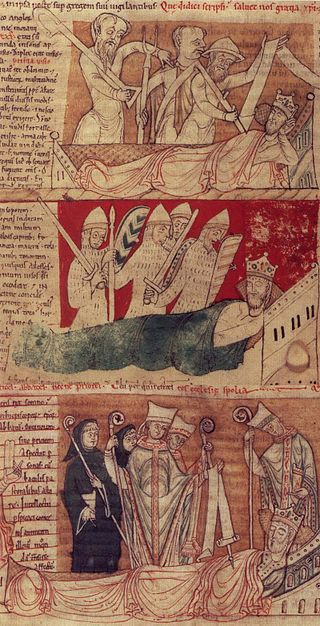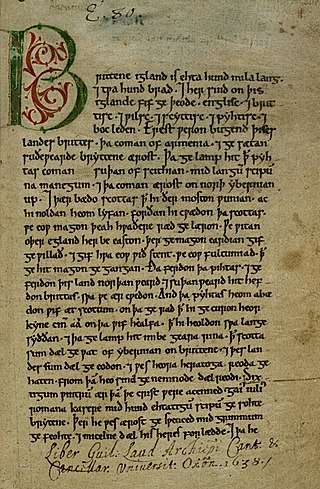Kenneth MacAlpin or Kenneth I was King of Dál Riada (841–850), and King of the Picts (848–858), of likely Gaelic origin. According to the traditional account, he inherited the throne of Dál Riada from his father Alpín mac Echdach, founder of the Alpínid dynasty. Kenneth I conquered the kingdom of the Picts in 843–850 and began a campaign to seize all of Scotland and assimilate the Picts, for which he was posthumously nicknamed An Ferbasach. He fought the Britons of the Kingdom of Strathclyde and the invading Vikings from Scandinavia. Forteviot became the capital of his kingdom and Kenneth relocated relics, including the Stone of Scone from an abandoned abbey on Iona, to his new domain.

Melrose is a town and civil parish in the Scottish Borders, historically in Roxburghshire. It lies within the Eildon committee area of Scottish Borders Council.
Waltheof was a 12th-century English abbot and saint. He was the son of Simon I of St Liz, 1st Earl of Northampton and Maud, 2nd Countess of Huntingdon, thus stepson to David I of Scotland, and the grandson of Waltheof, Earl of Northampton.

The Abbey of St Mary is a ruined Benedictine abbey in York, England and a scheduled monument.

St Mary's Abbey, Melrose is a partly ruined monastery of the Cistercian order in Melrose, Roxburghshire, in the Scottish Borders. It was founded in 1136 by Cistercian monks at the request of King David I of Scotland and was the chief house of that order in the country until the Reformation. It was headed by the abbot or commendator of Melrose. Today the abbey is maintained by Historic Environment Scotland as a scheduled monument.

The Book of Henryków is a Latin chronicle of the Cistercian abbey in Henryków in Lower Silesia, Poland. Originally created as a registry of belongings looted during the first Mongol invasion of Poland of 1241, with time it was extended to include the history of the monastery. It is notable as the earliest document to include a sentence written entirely in what can be interpreted as an Old Polish language. Currently the book is on exhibition in the Archdiocesan Museum in Wrocław. On October 9, 2015 the Book of Henryków was entered in the list of UNESCO's "Memory of the World."

Jocelin was a twelfth-century Cistercian monk and cleric who became the fourth Abbot of Melrose before becoming Bishop of Glasgow, Scotland. He was probably born in the 1130s, and in his teenage years became a monk of Melrose Abbey. He rose in the service of Abbot Waltheof, and by the time of the short abbacy of Waltheof's successor Abbot William, Jocelin had become prior. Then in 1170 Jocelin himself became abbot, a position he held for four years. Jocelin was responsible for promoting the cult of the emerging Saint Waltheof, and in this had the support of Enguerrand, Bishop of Glasgow.

Newbattle Abbey was a Cistercian monastery near the village of Newbattle in Midlothian, Scotland, which subsequently become a stately home and then an educational institution.

John of Worcester was an English monk and chronicler who worked at Worcester Priory. He is now usually held to be the author of the Chronicon ex Chronicis.

The Chronicles of the Kings of Mann and the Isles or Manx Chronicle is a medieval Latin manuscript relating the early history of the Isle of Man.
Beadwulf was the last Bishop of Candida Casa to be consecrated by the Northumbrian Archbishop of York. He appears in four years of the chronicles and nowhere else. Nothing else is known of him, and his sole historical significance is that he was a bishop of the short-lived Northumbrian See of Candida Casa at Whithorn.
Reinald Macer [also called Reginald] was a medieval Cistercian monk and bishop, active in the Kingdom of Scotland during the reign of William the Lion. Originally a monk of Melrose Abbey, he rose to become Bishop of Ross in 1195, and held this position until his death in 1213. He is given the nickname Macer in Roger of Howden's Chronica, a French word that meant "skinny".
Laurence de Ergadia was a thirteenth-century Scottish bishop. Probably from the MacDougall kindred of Argyll, Laurence had become a Dominican friar and presumably university graduate before being elected Bishop of Argyll, an election which took place sometime between 1262 and 1264. Although the election was quashed by the Pope in 1264, the Pope gave him a fresh provision to the bishopric. Laurence appears intermittently in the records during his three and a half decade episcopate, but his activities in his own diocese are badly recorded. He died as Bishop of Argyll sometime in either 1299 or 1300.

The British Library is a research library in London that is the national library of the United Kingdom. It is one of the largest libraries in the world. It is estimated to contain between 170 and 200 million items from many countries. As a legal deposit library, the British Library receives copies of all books produced in the United Kingdom and Ireland, including a significant proportion of overseas titles distributed in the UK. The Library is a non-departmental public body sponsored by the Department for Culture, Media and Sport.

The Liber Eliensis is a 12th-century English chronicle and history, written in Latin. Composed in three books, it was written at Ely Abbey on the island of Ely in the fenlands of eastern Cambridgeshire. Ely Abbey became the cathedral of a newly formed bishopric in 1109. Traditionally the author of the anonymous work has been given as Richard or Thomas, two monks at Ely, one of whom, Richard, has been identified with an official of the monastery, but some historians hold that neither Richard nor Thomas was the author.

The Anglo-Saxon Chronicle is a collection of annals in Old English, chronicling the history of the Anglo-Saxons.

John of Wallingford was a Benedictine monk at the Abbey of St Albans, who served as the abbey's infirmarer at some time between c.1246-7 and his death in 1258. He is now mostly known through a manuscript containing a miscellaneous collection of material, mostly written up by Wallingford from various works by his contemporary at the abbey Matthew Paris, which survives as British Library Cotton MS Julius D VII. This manuscript includes the so-called Chronica Joannis Wallingford or Chronicle of John of Wallingford.

Máel Coluim was an eleventh-century magnate who seems to have been established as either King of Alba or King of Strathclyde. In 1055, Siward, Earl of Northumbria defeated Mac Bethad mac Findlaích, the reigning ruler of the Kingdom of Alba. As a result of this military success against the Scots, several sources assert that Siward established Máel Coluim as king. It is uncertain whether this concerned the kingship of Alba or the kingship of Strathclyde.
The Winchcombe Chronicle is a Latin chronicle of the town of Winchcombe from about 1140-1145.












